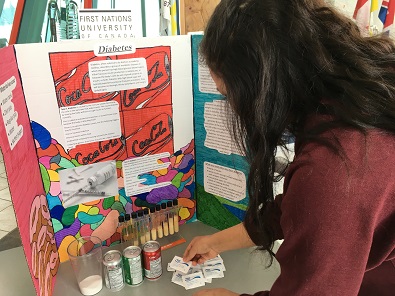Photo courtesy of Manfred Joehnck
It is a science fair with an Indigenous flair.
Dozens of students from the File Hills Qu’Appelle Tribal Council are participating in a competition that combines traditional First Nation knowledge with scientific theory.
About 40 displays have been set up at First Nations University where judges will pick the best of the best. Human anatomy, nutrition, disease, pollution — it’s all part of the displays.
Grade 11 student Jolene Agecoutay put together a display on diabetes because she knows how prevalent it is in the Aboriginal community.
“Yah, I am concerned about it,” she said. “I’ve got to slow down drinking pop and exercising more because I am an athlete and I should not be treating my body like that.”
A couple of rows over, grade five student, Cashton Asapace Black Sioux, demonstrated how a little bit of oil can cause a whole lot of environmental damage.
“You know it’s affecting our water in different kind of places, like it affected our water in Prince Albert — and half the waters in the world are affected,” he said.
The director of education for the File Hills Qu’Appelle Tribal Council, Maureen Johns, says the fair makes science relevant and easy to understand and may encourage students to take a science career.
“Students need to feel good about themselves,” she said. “So to bring them to such a fabulous building as the First Nations University of Canada, we want them to see themselves in science careers, we want them to see themselves in higher learning.”
Potash Corporation is the major sponsor, providing prizes like computers for the top entries.
